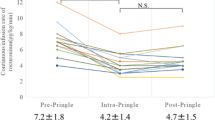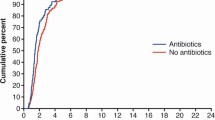Abstract
TOF (train-of-four) monitoring provides objective data in application of neuromuscular blocking agent. Thus, applicator-based differences are eliminated and optimum muscle relaxation is maintained during operation. In the present study, we aimed to compare the effects of target-controlled infusion system and standard TOF monitoring, on use of rocuronium. ASA I–II patients, who were aged between 18 and 75 years and scheduled for elective abdominal surgery at Haydarpaşa Numune Training and Research Hospital, were enrolled in the study. In order to evaluate neuromuscular blockade, the patients in Group 1 were connected to the acceleromyography device of the target-controlled infusion pump (Veryark-CLMRIS-I-China) while the ones in Group 2 were connected to the routinely used acceleromyography device (TOF Watch SX). There was no significant difference between groups regarding patient characteristics, the durations of anaesthesia and surgery, quality of intubation, time to extubation and time to recovery (TOF ratio of 0.9). Intubation time was significantly longer in Group 1 (Automated group) as compared to Group 2 (Control group) (p < 0.05). The total rocuronium amount used in Group 1 was found to be significantly higher than the amount used in Group 2 (p < 0.05). There was no clinical evidence of residual neuromuscular blockage or reoccurrence of neuromuscular blockage in any patient in either group. Both methods can be used for administration of neuromuscular blocker agent during moderate time anesthesia. No advantage was noted when rocuronium was administered via automatical infusion pump during anaesthesia.

Similar content being viewed by others
References
Mogensen JV. Neuromuscular monitoring. In: Miller RD, editor. Anesthesia. New York: Churchill Livinstone; 1994. p. 1345–61.
Vermeyen KM, Hoffmann VL, Saldien V. Target controlled infusion of rocuronium:analysis of effect data to select a pharmacokinetic model. Br J Anaesth. 2003;90(2):183–8.
Chuang CT, Fan SZ, Shieh JS. Muscle relaxation controlled by automated administration of cisatracurium. Biomed Eng Appl Basis Commun. 2006;18(6):284–95.
Schultheis L (2008) Clinical review Zemuron(rocuronium bromide). http://www.fda.gov/downloads/Drugs/DevelopmentApprovalProcess/DevelopmentResources/ucm072814.pdf.
Morgan GE, Mikhail MS, Murray MJ. Neuromuscular blocking agent. In: Morgan GE, Mikhail MS, Murray MJ, editors. Clinical anaesthesiology. New York: Lange Medical Books/McGraw-Hill Medical Publishing Division; 2010. p. 179–98.
Reid JE, Breslin SD, Mirakhur KR. Neositigmine antagonism of rocuronium block during anesthesia with sevoflurane, isoflurane or propofol. Can J Anaesth. 2001;48(4):351–5.
Oris B, Crul J. Muscle paralysis by rocuronium during halothane, enflurane, isoflurane and total intavenous anesthesia. Anesth Analg. 1993;77(3):570–3.
Murphy GS, Szokol JW. Monitoring neuromuscular blockade. Int Anaesthesiol Clin. 2004;42(2):25–40.
Cooper RA, Mirakhur RK, Clarke RSJ. Comparison of intubating conditions after administration of ORG 9426 (Rocuronium) and suxamethonium. Br J Anaesth. 1992;69:273–99.
Kopman AF, Klewicka MM, Kopman DJ, Neuman GG. Molar potency is predictive of the speed of onset of neuromuscular block for agents of intermediate, short and ultrashort duration. Anesthesiology. 1999;90(2):425–31.
Mahfouf M. Generalised predictive control (GPC) in the operating theatre. In: Linkens D, editor. Intelligent control in biomedicine. London: Taylor & Francis; 1994. p. 37–77.
Liu N, Chazot T, Genty A. Titration of propofol for anesthetic induction and maintenance guided by the Bispectral index: closed-loop vs manual control. Anesthesiology. 2006;104(4):686–95.
Hemmerling TM, Charabati S, Zaouter C, Minardi C, Mathieu PA. A randomised controlled trial demonstrates that a novel closed-loop propofol system performs better hypnosis control than manual administration. Can J Anaesth. 2010;57(8):725–35.
Locher S, Stadler KS, Boehlen T. A new closed-loop control system for isoflurane using bispectral index outperforms manual control. Anesthesiology. 2004;101(3):591–602.
Absalom AR, Sutcliffe N, Kenny GN. Closed-loop control of anesthesia using Bispectral index: performance assessment in patients undergoing major orthopedic surgery under combined general and regional anesthesia. Anesthesiology. 2002;96(1):67–73.
De Smet T, Struys MM, Neckebroek MM, Van den Hauwe K, Bonte S, Mortier EP. The accuracy and clinical feasibility of a new Bayesian-based closed-loop control system for propofol administration using the bispectral index as a controlled variable. Anesth Analg. 2008;107(4):1200–10.
Janda M, Simanski O, Bajorat J, Pohl B, Noeldge-Schomburg GF, Hofmockel R. Clinical evaluation of a simultaneous closed-loop anaesthesia control system for depth of anaesthesia and neuromuscular blockade. Anaesthesia. 2011;66(12):1112–20.
Apfelbaum JL. Mivacurium chloride administration by infusion. Acta Anaesthesiol Scand. 1995;39(106):55–7.
Wehbe M, Arbeid E, Cyr S, Mathieu PA, Taddei R, Morse J, Hemmerling TM. A technical description of a novel pharmacological anesthesia robot. J Clin Monit Comput. 2014;28(1):27–34.
Schumacher PM, Stadler KS, Wirz R, Leibundgut D, Pfister CA, Zbinden AM. Model-based control of neuromuscular block using mivacurium: design and clinical verification. Eur J Anaesthesiol. 2006;23:691–9.
Author information
Authors and Affiliations
Corresponding author
Ethics declarations
Financial disclosure
The authors have no financial relationship with the organization that sponsored the research.
Conflict of interest
The authors have no conflict of interest.
Ethics committee approval
Ethics committee approval was received for this study from the ethics committee of Haydarpasa Numune Teaching and Research Hospital (HNEAH-KAEK No: 2012/78).
Informed consent
Written informed consent was obtained from patients who participated in this study.
Rights and permissions
About this article
Cite this article
Ozturk Arikan, F.G., Turan, G., Ozgultekin, A. et al. Rocuronium: automatic infusion versus manual administration with TOF monitorisation. J Clin Monit Comput 30, 545–550 (2016). https://doi.org/10.1007/s10877-015-9751-2
Received:
Accepted:
Published:
Issue Date:
DOI: https://doi.org/10.1007/s10877-015-9751-2




